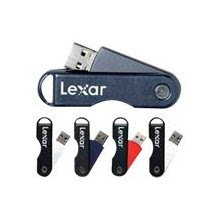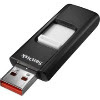 A must have when doing genealogy is to have a Flash Drive (Thumb, Jump or whatever you want to call it Drive - portable drive). These are small yet hold vast amounts of information. They are so easy to store - just slip it in your pocket, purse, backpack, wallet, key chain, etc. If you get in the habit of working off of a flash drive, you can always have your files right at hand whether you carry around a computer or not....this is your computer in a way. This little flash drive can hook up to any computer and allow you to access YOUR information.
A must have when doing genealogy is to have a Flash Drive (Thumb, Jump or whatever you want to call it Drive - portable drive). These are small yet hold vast amounts of information. They are so easy to store - just slip it in your pocket, purse, backpack, wallet, key chain, etc. If you get in the habit of working off of a flash drive, you can always have your files right at hand whether you carry around a computer or not....this is your computer in a way. This little flash drive can hook up to any computer and allow you to access YOUR information. There are a wide variety of styles and sizes (meaning how much information they will hold). You will probably want one that is 1-4 gigabytes - that will hold tons of information, pictures, and documents. They are quite reasonable in price also. (These flash drives can be purchased at almost any discount or electronics store or on the Internet.)
 - Insert flash drive (thumb drive) into the USB port on your computer. Most newer computers have these ports in easy to locate positions...in front or on the sides of lap tops. Look around. It is the little rectangle port that will fit the smaller protruding part of the flash drive. If you have an older computer, you may need to look in the back. You might also need to buy a multiple port which will expand your one port into several allowing you to use several devices using USB ports at the same time.
- Insert flash drive (thumb drive) into the USB port on your computer. Most newer computers have these ports in easy to locate positions...in front or on the sides of lap tops. Look around. It is the little rectangle port that will fit the smaller protruding part of the flash drive. If you have an older computer, you may need to look in the back. You might also need to buy a multiple port which will expand your one port into several allowing you to use several devices using USB ports at the same time.- Go to START (or desk top) – then My Computer and double click on the desired drive -
A window will open showing the different plug in divices on your computer (see right side of picture). This is where you will need to know if you want in your C drive, your disk drive (A, B, D, or other), or into your flash drive (which will be allocated by a letter drive - like E).
Double click on the drive you want to open.
A window will open showing the different plug in divices on your computer (see right side of picture). This is where you will need to know if you want in your C drive, your disk drive (A, B, D, or other), or into your flash drive (which will be allocated by a letter drive - like E).
Double click on the drive you want to open.
You will now be able to access your flash drive.
Now you really need to understand FILES on your computer to help you maneuver around to find what you are looking for. Check out "HOW TO ORGANIZE FILES" to help you better understand what to do when you do get to the drive you want.
Now you really need to understand FILES on your computer to help you maneuver around to find what you are looking for. Check out "HOW TO ORGANIZE FILES" to help you better understand what to do when you do get to the drive you want.
* NOTE: Always close down your flash drive before you disconnect it from the computer. To do this, look at the bottom right corner of your computer. Find the little icon for your flash drive. Click on the icon to open it up. It will ask if you want to close, say yes (sometimes all you have to do is click on the link to shut down the flash drive). Once you have shut down the flash drive, you may remove the flash drive from the USB port. Failure to shut down the flash drive before removing may result in the loss of information or destruction of your flash drive.
Note: You should always make back ups of your information. Do not trust that one flash drive will be enough. It can be easily destroyed just as a cd/dvd or even the crashing of your hard drive.


No comments:
Post a Comment